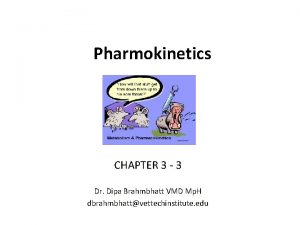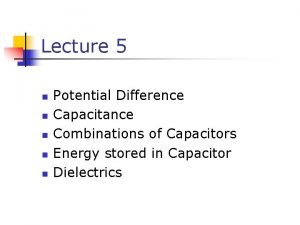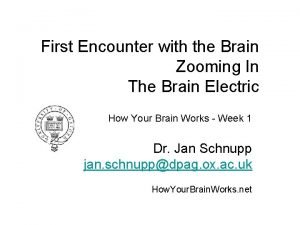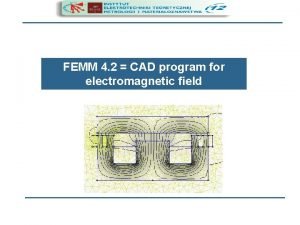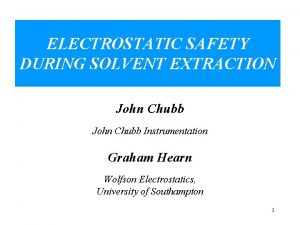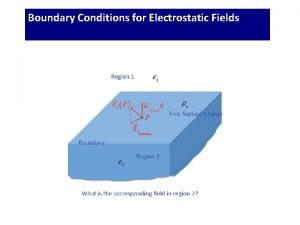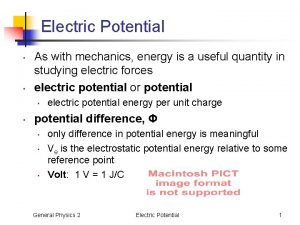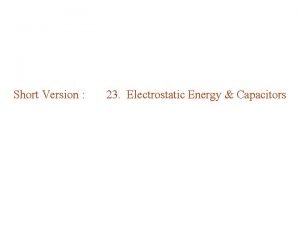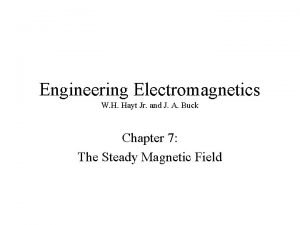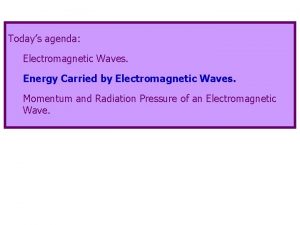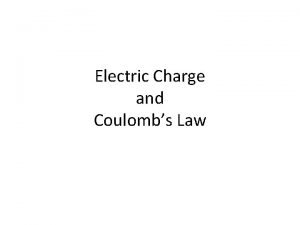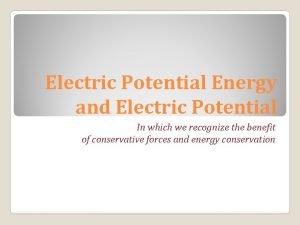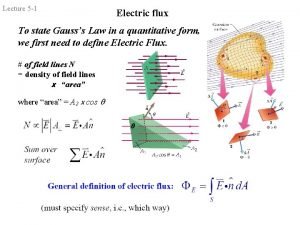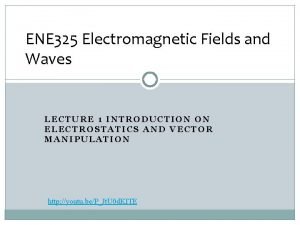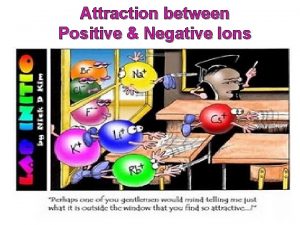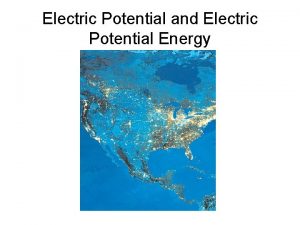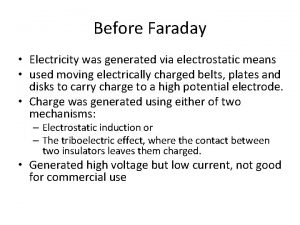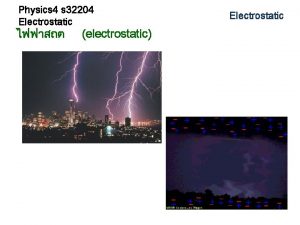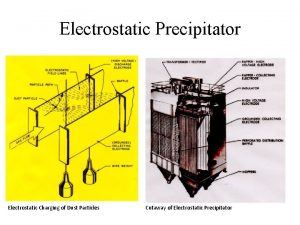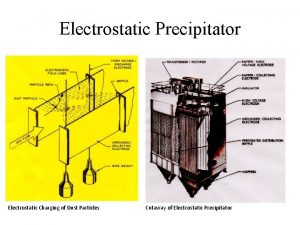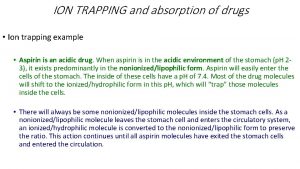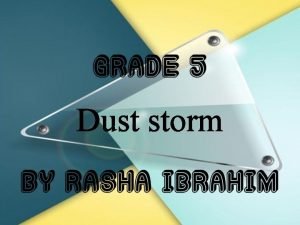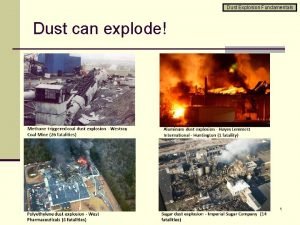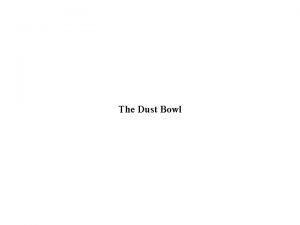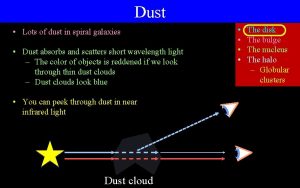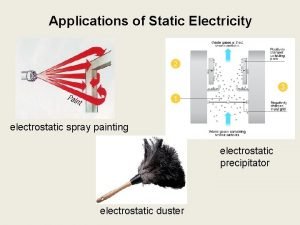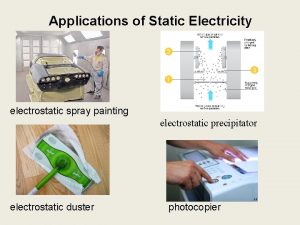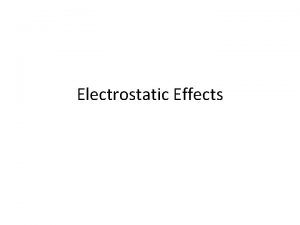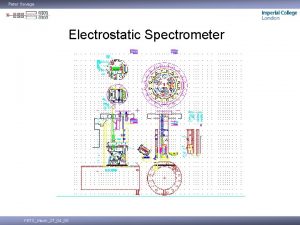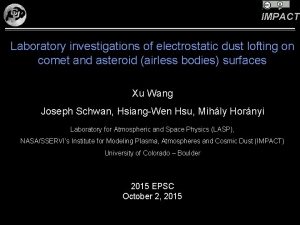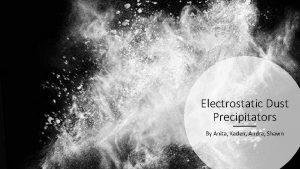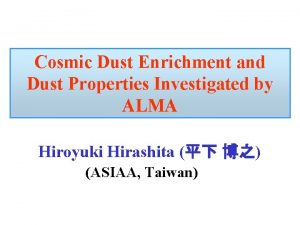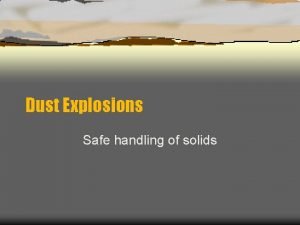Electrostatic Trapping of 3 Si O 2 Dust





























- Slides: 29

Electrostatic Trapping of 3 Si. O 2 Dust Rings around a Dipole Magnet R. Sheldon, E. Thomas Jr, D. Gallagher, M. Adrian, M. Abbas, P. Craven & E. Reynolds National Space Science & Technology Center/ Auburn U. / WVU Aug 2, 2002

Abstract We report on the observed trapping of 3 Si. O 2 dust rings around a dipole magnet as a consequence of hot plasma convection. We show that Birkeland's 1910 terrella experiments, repeated in an 18" bell jar, produce a DC-glow discharge plasma in a flattened annulus around the central magnet. This highly anisotropic, hot plasma produces a quadrupolar space charge that is estimated to be tens of n. F of capacitance in our system. The space charge, in turn, produces an electrostatic trap which suspends a dusty plasma against the force of gravity. We generalize that any magnetosphere when injected with hot plasma will develop a quadrupolar electrostatic trap. We present a simple kinetic theory for this effect and propose that quadrupolar traps may be operating at Earth, Jupiter and Saturn. Such a trap could theoretically account for the relative thinness of Saturn's dust rings, as well as the energy driver of galactic jets. We will present data on the meridional structure of this space charge as measured in the NASA/MSFC/NSSTC Spinning Terrella Lab as well as our progress in simulations.

POLAR/CEPPAD observations Sheldon et al. (GRL 1998) reported observations of 40 ke. V ion beams simultaneous with 90 ke. V pancake ion injection. We believe the space charge developed by the pancake, plasmasheet injected ions generated the 40 k. V field-aligned potentials that extracted the ionospheric species (O+, He+) observed here at 40 ke. V. Note the similarities to the spinning terrella observations with external plasma injection.

Theory: Parallel E-fields ; ; Whipple, JGR 1977. Ne = Ni, quasi-neutrality n k. Te F E || When electrons and ions have different pitchangle distributions, then a field-aligned potential develops that attempts to maintain quasi-neutrality. Whipple develops this formalism for a background cold Maxwellian with a hot beam. The solution is transcendental, and can be solved graphically, as shown schematically above. The first solution, where electrons of energy k. Te produce a voltage of about the same amount, is well known. Rarely discussed is the second solution that produces large parallel potentials, of the same order as the energy of the hot ion beam. This may be the mechanism operating in our system, and setting up large space charge potentials.

Space Charge Spectroscopically DC-glow discharge around a Nd-B permanent magnet biassed at constant voltage (~-400 V) but at varying pressures of air, beginning from 20 m. Torr (bottom center) to 400 m. Torr (bottom right). Note the changing colors of the discharge, indicating an ion-dominated plasma at the equator, and an electron dominated plasma over the poles; spectroscopic evidence for the quadrupolar nature of this dipole controlled discharge. Note the shrinking radial distance of the discharge with increasing pressure, showing the effect of the 10 x greater collision frequency. Note that the "glow discharge" pressure for air is traditionally at even greater than this, but the magnet effectively enhances the ionization cross section by confining plasma. This separation of charge suggests space charge is developing at the equator.

Lab Experiment TOP: (left panel) First indication of arcs discharging to grounded magnet showing as freckles on Ni-plated magnet. (right panel), evidence that discharges follow field lines from top to bottom of grounded magnet. Since magnet is conducting, discharge must have high voltage at equator. BOTTOM: similar behavior is demonstrated with a symmetric no-electrode arrangement with -400 V bias on magnet itself. Arcs indicate that space charge develops whenever plasma is present around a dipole magnet.

Lab Experiment TOP: Grounded magnet with 600 V probe injecting plasma off to one side. Right panel shows production of multiple arcs following field-lines of magnet. Left panel shows the more symmetric arrangement caused by rotating the magnet. BOTTOM: Direct production of plasma by -400 V bias applied to magnet directly. Symmetry no longer requires spinning the magnet. Similar arcs are generated showing that plasma space charge develops regardless of the mechanism of injection, that it is not due to asymmetries of electrodes.

Langmuir Floating Probe Inexpensive X-Y table with mm visual positioning tool. Langmuir probe scans the meridional plane of the magnet. Magnet is superglued to hollow alumina rod with -400 V bias run internally. It shows effects of sputtered carbon covering the Ni-plating, except for an equatorial band where plasma contacts the magnet and scours it clean. Low Curie point of Nd-B magnets necessitate that data "runs" be kept less than 10 minutes to avoid overheating (and demagnetizing) the magnet. Between runs, air is reintroduced into the chamber to cool magnet.

Inconclusive Results Meridional cut through the plasma discharge of a Nd. B magnet. Etch-A-Sketch was used to move a 6" long Langmuir probe in a plane through the discharge region. Photographs of each location were made in real time, while a HP voltmeter recorded the floating probe voltages every 3 seconds (crosses). Photographs were used to reconstruct the location of the probe, and IDL graphics used to regularize and plot the voltage contours. As expected, 3 -5 Volts were observed in a depression near the plasma, the space charge that traps the dust. However, discharges of the plasma during the measurement introduced considerable noise. Differential measurement will hopefully improve this data. (Not completed at time of conference. )

Dust Tracer Experiment Diode Laser Langmuir probes disturb the plasma that they are trying to diagnose, so we thought to use a “test particle” approach with charged dust, illuminated by a laser. We show a 18" Glass Bell Jar at 400 m. Torr with purple DC glowdischarge plasma surrounding a ceramic, Nd-B magnet, and illuminated with 532 nm 70 m. W green diode laser. Si. O 2 3 dust is charged negative and dispersed by plasma, trapped in the vicinity of the magnet, and illuminated with the laser. A vibrating mirror (not shown) was used to spread the laser into horizontal sheet, producing the multiple reflections seen around the glass bell jar.

Pencil Laser illumined spots The pencil beam of the laser illumined dust trapped in the vicinity of the magnet. Several thousand dust grains per cubic centimeter (dust puppies) are levitated against gravity in a ring around the magnet. In the top frame, the laser is tangent to the dust collection, in the bottom frame the laser slices through the ring of dust in two places, producing two spots.

Scanning Laser illumined ring By using a small mirror, vibrated at 20 Hz with a small hobby motor, we were able to scan the laser beam across the dust ring. In the foreground are the reflections of the scanned beam off the glass bell jar and Lexan shield. The dust ring may be a bit thicker vertically than displayed due to finite width of the laser illumination. However, the abrupt radial thickness is real, though not understood. (We had expected a sheet of dust. ) We note the similarity to Saturn's rings, and postulate that electrostatic trapping may be occuring there as well. Note that magnetic forces are negligible on the dust grains, so that trapping is entirely electrostatic.

Multiple dust rings When printed at poster size, we realized that there is a faint 2 nd ring outside the first. Though this might be due to time variations in the electric field, caused by arcing in the chamber, we believe it may also be a steady-state phenomenon of the dust itself. Again, we do not presently have a theory for radial structure of the electrostatic charge supported by the hot plasma trapped around a magnet. If we apply this theory to Saturn, we need a source of hot plasma that will set up the electrostatic charge. This is the subject of the second part of this poster.

Dusty Conclusions * We demonstrate a good laboratory analog to field-aligned flows observed in space. We also demonstrate a highly analogous Saturnian ring system when dust is added to such a quadrupolar electrostatic space charge. * Space charge is observed to develop in both laboratory and space that carries important consequences for dipole trapped plasmas. Evidence for this space charge is: - Ionospheric beams of He+, O+ at 40 ke. V coming simultaneous with pancake trapped plasmasheet ions. - Field-aligned discharges in laboratory system that require a large voltage difference between the equator and the poles. - Discharges are produced both by external injection of hot plasma, or by DC-glow discharge from the central magnet. The second technique is more symmetric and analogous to very rapidly spinning magnets. - Dust charges negatively in a plasma discharge, and was found to collect at the magnet equator, supported against the force of gravity by electrostatic forces. - Neutral atom glow from the laboratory system indicate an electron impact emission near the poles of the magnet, and an ion impact emission near the equator of the magnet, or a quadrupolar spectroscopic signature. - Many astronomical observations of quadrupoles (accretion disk with a pair of opposite jets) suggest that this configuration is ubiquitous in nature. (Ap. J paper in progress. )

History and Problem *The origin of energetic particles in magnetospheres is not necessarily a solved problem. Generally the tail is taken to be the acceleration region and subsequent adiabatic compression produces the radiation belts, but actual mechanisms that energize solar wind from 1 ke. V/nuc to 10’s or 100’s of ke. V (before adiabatic compression) are all speculative. For example, Speiser orbits occupy a region of phase space that is a set of measure zero. This reduces the efficiency of such a mechanism for accelerating particles. If we are to posit an electrostatic trapping of dust, we will need a source of this hot plasma at Saturn’s E-ring. • Recent discoveries at Earth provide a scalable model for hot plasma at Saturn, that we use to predict plasma energies. • POLAR discovered a high-altitude Me. V electron population trapped in the cusp (Sheldon et al. GRL 1998) • POLAR saw energetic ions in diamagnetic cavities in the cusp as well (Chen et al. JGR 1998) • These cavities are scaled up to other magnetospheres to estimate the energy spectrum observed in the outer planets.

Maxwell / Chapman �axwell (~1880) showed that a perfect conductor adjacent to M a dipole formed an image dipole. Two dipoles have some quadrupole regions, as indicated by red ellipses. �hapman (~1930) realized that a flowing neutral plasma was C like a perfect conductor “wrapping around” the dipole. Thus every dipole embedded in a plasma, MUST form a quadrupole � A Nobel prize was awarded for a quadrupole ion trap (Paul trap), which in a Magnetosphere, is the high latitude cusp.

Parallel Dipoles w/ ring current SIDE TOP -Two Nd-B magnets are used in the same configuration as the Lab Experiment described earlier. Both magnets were biassed at 400 V, and produced annular plasma traps. However they interacted with each other much like Maxwell’s 2 dipoles. A high latitude minimum forms, and Shabansky orbits connect equator trap with cusp trap. These cusps are bistable, as seen in time sequence on the left, flipping from North to South.

Plasma Trap @ Cusps TOP SIDE If instead of giving both magnets the same – 400 V bias, we lower one magnet to ground, the following configuration is observed: -Plasma generated by electrons on one magnet, feed into other trapping field due to diffusion though "x-line“, since the plasma is highly diffusive. -Like northward Bz, this feeding happens at the cusps, as predicted by Siscoe et al. -The cusps themselves hold the plasma long enough to glow, showing that the cusp can trap particles itself, not just migrating equatorial particles. -Are they seen in a real Magnetosphere?

Sheldon et al. (GRL 98), observed 1 Me. V electrons at L~12, adiabatically but not diffusively connected to the radiation belts. It had a trapped, 90 deg pitchangle dependence. Phase space density in color, pink shows pitchangles. Black dots are on an adiabat, demonstrating similar densities at L=5 and L=14. So who supplies who?

Tracing particles in cusp Sheldon et al. , (GRL 98) traced 1 Me. V electrons through cusp to demonstrate that they possessed 3 adiabatic invariants, and were permanently trapped, as expected in a quadrupole trap. Can this trap also accelerate them?

Plasma is Diamagnetic B D B If plasma is trapped, as we demonstrated by tracing the particles in the cusp, then it reacts back on the magnetic field, much as the ring current produces a reduction in field strength seen on the surface of the earth. This diamagnetic effect grows with the energy density of the plasma, and at sufficiently high trapped density, can expel the external trapping magnetic field. This can produce a “bubble” of close to zero field strength. Since the cusp is a region of very small field strength, these bubbles are likely to form there.

Cusp Diamagnetic Cavities Chen et al (JGR 98) showed that indeed, diamagnetic cavities were observed in the cusp. These cavities were filled with mirror mode waves and high turbulence, such that d. B ~ B. This makes diamagnetic cavities ideal places for stochastic acceleration, and he found energized ions in these cavities. Note that often it not the energetic plasma, but the cold, dense plasma that maintains the cavity.

MLT/MLAT/Radial Occurrence Chen (JGR 98) showed that these cusp diamagnetic cavities occur near the outer cusp. The left panel shows a X-Y plot of these observations, the right panel shows the X-Z distribution. The CDC cluster in the cusp, which is not surprising, because the cusp is the region of weakest field. The cusp is also a diverging field. It is known that diamagnetic cavities have a buoyant force, so what would keep these cavities in the m’sphere? Wouldn’t they squirt out like a watermelon seed?

Diamagnetic Levitation water drop small frog live frog The University of Nijmegen shows how all substances are diamagnetic, and can be levitated harmlessly by the diverging (cusp-like) field in the 32 mm bore of a 16 T Bitter magnet. The buoyant force balances the gravitational force in this case.

Force-free conditions for CDC in a M’sphere cusp 1) Place small dipole in the cusp, anti-aligned = a CDC. 2) Calculate B = BDIPOLE + Bt 96 for a 1 Re bubble around the little dipole. 3) Since E=m. B 2 and FX = d. E/dx, we repeat this calculation for a little dx, dy, dz motion and take differences to get F. (We also get d. F/dx too. ) 4) Finally we adust the strength of BDIPOLE until we can get a zero force. 5) We plot these quantities to find a force free solution 6) Black lines are contours of B 2. Green line shows F=d. E/dx = 0. Red line show where d 2 E/dx 2 = d. F/dx = 0, showing that green lines are in regions of stability

The Interpretation of the Simulation a B 2 6 8 r r We interpret this to show several things about CDC: a) The CDC do not squirt out of the magnetosphere, but find a stable location inside. b) This stable position moves inward as the size of the CDC grows larger c) This is understood to be caused by a “wall” of magnetic field generated by the Chapman-Ferraro currents at the magnetopause, as shown schematically in the second figure.

Radiation Belt Scaling Law for all M’spheres �Brad ~ Bsurface= B 0 �Bcusp ~ B 0/Rstag 3 �Ecusp ~ v 2 perp~ (Bcuspr)2 ~ [(B 0/Rstag 3)Rstag] � = E/B is constant �Erad= 5 Me. V for Earth Erad-planet~(Rstag-Earth/Rstag-planet)(B 0 -planet/B 0 -Earth)2 Erad-Earth If these stable CDC are responsible for accelerating the energetic particles in a planetary magnetosphere, we want to formulate a scaling law for the magnetospheres of outer planets. 1) We take the magnetic field of the radiation belts of the planetary magnetosphere to be approximately surface field. 2) We take the cusp field to be diminished by distance to the stagnation point at the nose. 3) We set the maximum energy in the cusp to be determined by the gyroradius of an energetic particle in a CDC. 4) Calibrating with Earth (5 Me. V) we estimate the adiabatic energization from cusp to rad-belt, giving last equation.

Scaled Radiation Belts Planet R STAG B 0 (n. T) 330 Mercury 1. 4 Earth 10. 4 31, 000 <6 Mars 1. 25 Jupiter 65 430, 000 21, 000 Saturn 20 23, 000 Uranus 20 14, 000 Neptune 25 ERAD 4 ke. V 5 Me. V < 1. 5 e. V 150 Me. V 1. 2 Me. V 3. 5 ke. V@7 1. 4 Me. V 0. 42 Me. V Using the scaling law derived from Earth, we get the above estimates for the energy of the radiation belts at all the planets. For all planets that have been explored, this prediction is relatively accurate, predicting <10 ke. V for Mercury, 0 for Mars and Venus, and >100 Mev for Jupiter. We calculate the plasma temperature for Saturn’s rings at Rs=7, finding a warm plasma capable of 1 k. V electrostatic field.

Conclusions � Dust can be trapped in an electrostatic field produced by warm plasma trapped around an inhomogeneous dipole field. This has been demonstrated in the laboratory, and observed in space. � Cusp Diamagnetic Cavities are stable in the quadrupole cusp of all magnetospheres due to Chapman Ferraro currents. These CDC are filled with waves and make excellent accelerators. We observe these CDC at Earth simultaneous with energized particles. � Scalings based on a CDC at Earth produce a reasonable estimate of Jupiter’s radiation belt energy, predict that Mars will not have a radiation belt, and lead to predictions for the other planets. � Scaling this CDC warm plasma to Saturn’s Ering, we predict a 1 -2 k. V electrostatic potential well for trapping charged dust. � This would account for the thinness of Saturn’s E-ring, a topic not addressed by current models.
 To kill a mockingbird vocabulary chapter 2
To kill a mockingbird vocabulary chapter 2 First bypass effect
First bypass effect Symbols of to kill a mockingbird
Symbols of to kill a mockingbird Sequential linear menu
Sequential linear menu What is ion trapping in pharmacology
What is ion trapping in pharmacology Prostagalndins
Prostagalndins Piety in a sentence
Piety in a sentence What is ion trapping in pharmacology
What is ion trapping in pharmacology Electric potential
Electric potential Drexelbrook rf admittance
Drexelbrook rf admittance Electrostatic attraction
Electrostatic attraction Femm electrostatic
Femm electrostatic What is an electrostatic attraction
What is an electrostatic attraction Electrostatic instrumentation
Electrostatic instrumentation Electrostatic boundary conditions
Electrostatic boundary conditions Ev kinetic energy
Ev kinetic energy Electrostatic energy density
Electrostatic energy density Magnetic field intensity
Magnetic field intensity Energy density of em wave
Energy density of em wave Electrostatic plotter
Electrostatic plotter Electrostatic meter chapman
Electrostatic meter chapman Two 8 gram equally charged balls are suspended on earth
Two 8 gram equally charged balls are suspended on earth Electric potential
Electric potential Electrostatic force
Electrostatic force Electrostatic shielding
Electrostatic shielding Esd marking
Esd marking Si unit of permittivity of free space
Si unit of permittivity of free space What is the attraction between positive and negative ions
What is the attraction between positive and negative ions How is potential energy used
How is potential energy used Wimshurst machine
Wimshurst machine

